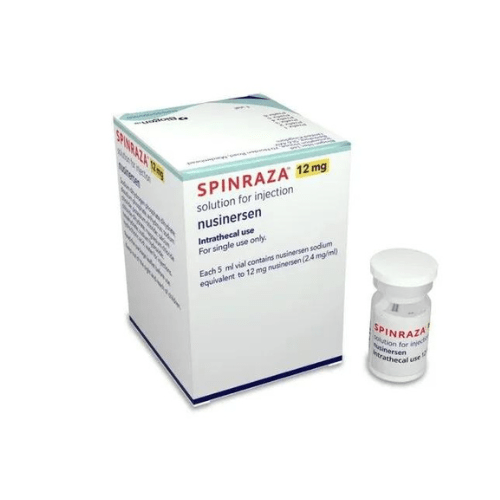
n the realm of neurodegenerative disorders, spinal muscular atrophy (SMA) poses a significant challenge, gradually eroding motor functions and hindering independence. Families have long faced the constraints of SMA, eagerly anticipating a breakthrough.
Indication Of Spinraza
Spinraza (Nusinersen) is an antisense oligonucleotide indicated toward survival motor neuron-2 (SMN2), indicated for the pediatric and adult treatment of spinal muscular atrophy (SMA).
Understanding Spinal Muscular Atrophy
SMA, stemming from a mutation in the SMN1 gene, disrupts survival motor neuron (SMN) protein production, vital for motor neuron survival. Insufficient SMN protein leads to the progressive loss of motor neurons, resulting in muscle weakness, atrophy, and diminished motor function.
Symptoms of Spinal Muscular Atrophy (SMA)
The symptoms of Spinal Muscular Atrophy (SMA) vary based on the type and severity of the condition. SMA is generally classified into several types, with Type I being the most severe and Type IV being the least severe. Here are the common symptoms associated with different types of SMA:
1. Type I (Severe SMA)
- Muscle Weakness: Infants with Type I SMA often exhibit generalized muscle weakness, especially in the core muscles.
- Poor Muscle Tone: Reduced muscle tone, known as hypotonia, is a characteristic feature.
- Respiratory Issues: Breathing difficulties are common due to weakness in the muscles involved in respiration.
2. Type II (Intermediate SMA)
- Delayed Motor Milestones: Children with Type II SMA may experience delays in reaching motor milestones like sitting or standing.
- Muscle Weakness: There is noticeable muscle weakness, but respiratory function is typically less affected than in Type I.
3. Type III (Mild SMA)
- Motor Development Delays: Children with Type III SMA may have delays in motor development but often learn to walk.
- Muscle Weakness: Muscle weakness is milder compared to Types I and II.
4. Type IV (Adult-Onset SMA)
- Mild Symptoms: Symptoms may be mild and typically manifest in adulthood.
- Muscle Weakness: Adults with Type IV SMA may experience progressive muscle weakness but often maintain the ability to walk.
5. Common Symptoms Across Types
- Muscle Atrophy: SMA generally involves muscle wasting or atrophy over time.
- Joint Contractures: Tightness or contractures in the joints can occur.
- Tremors or Twitching: In some cases, individuals with SMA may experience tremors or muscle twitching.
SMA varies widely among individuals. Early diagnosis and personalized management are crucial for improving the quality of life. Regular medical check-ups and targeted interventions are essential for addressing symptoms and promoting overall well-being.
The Genesis of Spinraza
Developed by Biogen, Spinraza (Nusinersen) introduces an innovative approach to SMA treatment called antisense oligonucleotide (ASO) therapy. It targets the SMN2 gene, a backup for SMN1. Spinraza binds to a specific SMN2 region, promoting exon 7 inclusion during RNA processing. This inclusion facilitates full-length, functional SMN protein production, offering protection against motor neuron loss.
FDA Approval: A Pivotal Moment
On 23rd December 2016, Spinraza received accelerated FDA approval, a transformative milestone in SMA treatment. Approval hinged on clinical trials showcasing Spinraza’s capacity to enhance motor function, extend survival, and slow skill decline in SMA patients.
Mechanism of Action:
Spinraza selectively binds to a specific SMN2 gene region, masking it during RNA processing. This masking promotes exon 7 inclusion, facilitating full-length, functional SMN protein production. While levels may be lower than SMN1 protein, it still offers functional capacity, shielding motor neurons from degeneration.
Benefits of Spinraza: Life Changing Therapy
Clinical trials underscore Spinraza injection remarkable benefits such as
- Improved motor function
- Increased survival
- Slowed skill decline
- Translating into enhanced mobility
- Enhances the patient’s life
Dose and administration of Spinraza
The recommended dosing of Spinraza involves an initial loading phase consisting of four lumbar puncture administrations. The first three doses are given at 14-day intervals, followed by the fourth dose 30 days after the third. Subsequently, maintenance doses are administered every four months to sustain the therapeutic effects in spinal muscular atrophy (SMA) treatment. The dosage and administration schedule are tailored to individual patient characteristics, and it is essential to consult with a healthcare professional for personalized guidance on Spinraza’s appropriate use.
Warning and Precaution
Thrombocytopenia and Coagulation Abnormalities: This treatment may increase the risk of bleeding. Your doctor will conduct tests before each dose to check for these issues.
Renal Toxicity: This medication could affect your kidneys. Your doctor will perform urine protein tests before each dose to monitor your kidney health.
Pregnant women: Insufficient data are available to assess the developmental risks of using Spinraza in pregnant women.
Breastfeeding women: There is a lack of adequate data regarding the developmental risks of Spinraza use in breastfeeding women.
Geriatric population: Since SMA primarily affects children and young adults, there is no geriatric experience with Spinraza.
Side Effects and Risks
Potential side effects encompass headache, upper respiratory infection, fever, and constipation. Rare instances report severe effects like low platelet count and spinal cord inflammation. Vigilant health monitoring is crucial, with concerns promptly reported to healthcare providers.
Conclusion:
Spinraza stands as a transformative breakthrough in SMA treatment, offering hope to patients and families. Ongoing research will unveil its long-term effects, emphasizing Spinraza’s role in conquering SMA. As the journey continues, Spinraza serves as a beacon, guiding towards a future where SMA’s impact diminishes, enriching lives with new possibilities.
FAQs
What is Nusinersen injection, and how does it work?
Nusinersen injection is a medication designed for the treatment of spinal muscular atrophy (SMA). It functions as a survival motor neuron-2 (SMN2)-directed antisense oligonucleotide, working to increase the production of survival motor neuron (SMN) protein crucial for motor neuron survival.
How to buy Spinraza online?
Acquiring Spinraza online has become more convenient. To obtain this medication, exclusive to the US and Europe, you can reach out to the SANSFRO team or other specialized firms experienced in importing medicines from these regions.
What is Spinraza price?
Spinraza price depends on various product specifications and factors. For precise pricing information, please get in touch with our Patient Support Team at (+91) 93157 05373 or email us at help@sansfro.com. Our team can provide you with accurate and current cost details for Spinraza in the Indian market.
Reference



